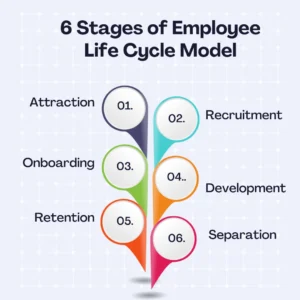Employee life cycle is crucial for every organization but not all organizations give it enough importance. Once an employee joins the company it is taken for granted that they will be working to the best of their ability and will heavily contribute to the productivity of the company. If we look closely we understand that employee engagement plays an important role in their productivity. Furthermore, the better the employee engagement the greater the organizational productivity.
Employee goes through various stages during employment. Multiple factors affect employee engagement throughout these different stages of your employee life cycle. Customizing the strategy within your organization for various specific requirements of the employee life cycle’s stages. The employee life cycle management will help you improve employee satisfaction and overall employee experience.
What is Employee Life Cycle Model?
The employee life cycle model talks about the different stages employees go through during their employment. The stages are defined according to the employee’s interactions with an organization. The first stage of the employee life cycle is considered attraction and your employee life cycle is completed at the employee’s separation from the company.
In this blog, we will look at all the stages of employee life cycle in detail.
6 Stages of Employee Life Cycle
Every employee goes through a journey. All the stages of employee life cycle are important for the employee’s productivity. At each stage, there are different roles and responsibilities for both the company and the employee. Here are the stages of employee life cycle model discussed in detail and the strategies to help you improve engagement and productivity at your company.

1. Attraction
Attraction is the first stage of the employee life cycle and it is where the employee gets to know about the company for the first time. The attraction stage should start a lot before your recruitment process. It is where employees may think about your company as a good place to work in future. The attraction stage is highly affected by employer branding. How well a company do their employer branding decides how well it can attract top talent in the market to get on board and stay engaged for the journey throughout various stages of employee life cycle.
It is best to start working on your employer brand immediately. Building a good employer brand begins with creating a healthy work culture. When you have a healthy work culture, your current employees become your brand ambassador. The best employer branding happens when your employee talks positively about your company to their friends and family and also, share posts in their social media accounts showcasing their happiness working with the company. That means your employees directly and indirectly can help you to build a positive and attractive image as a good employer.
2. Recruitment
Recruitment is one of the stages of the employee life cycle model and it starts right from the realization that you need to hire a new employee for your company. Whether this is a new or an existing position you need to ensure that you treat your prospective employees with fairness and respect.
There are many steps in the recruitment process. At each stage, you need to understand the needs of the position as well as the perspective of the candidates to ensure hiring the right employees.
One of the things that you should ensure before looking for prospects outside is that you don’t have suitable talent currently within the company that you can promote for this vacancy. Furthermore, your employees can help you to find the right candidate through an employee referral program. Many modern recruitment software solutions make it easy to manage and track referrals, and incorporating them into your recruitment management system can streamline the entire process.
Start with understanding the requirements of the organization and design the desired job description. Be clear about the experience, skills and responsibilities of the position. Make your job post appealing to your target candidates by using inclusive language and talking about the benefits of working in the organization throughout the employee life cycle.
The foundation of the whole employee experience starts with how you treat the candidates in the screening process. Make the process short and simple for maximum participation. It’s also important to maintain complete transparency about every aspect of the recruitment process. Inform candidates about the estimated time for every screening round as well as the compensation and benefits you offer. Transparency can help you to build trust at this stage.
3. Onboarding
Onboarding is the stage in the employee life cycle where they need to get all the support to feel comfortable and productive in their new position. Everyone wants to start their new journey in the organization with a positive perspective and you can help them to maintain that positive perspective.
The onboarding stage in the employee life cycle is supposed to make employees feel comfortable. It’s also an essential part of employee life cycle management as it builds a strong foundation for employee experience and employee engagement.
Ensure that you provide them with all the necessary information about the values and the goals of your company. That helps them relate their own values and align their individual goals accordingly. Having clearly defined values also helps you to build employee loyalty towards the company.
Make sure that during this phase of the employee life cycle, they get all the equipment and resources they need for their work. It is best to provide some basic knowledge and training which will help them to adapt and grow in the company faster.
A company culture varies from organization to organization. So employee should have a clear idea about what are their role and responsibilities at your company. Set clear expectations and provide a brief overview of the appraisal. It is also best to let employees know about the career path in your company so that they can make their own career plans and act accordingly.
Last but not least, when it comes to onboarding don’t forget regular follow-ups. That will help your employees to adapt faster and resolve challenges as soon as they arrive.
4. Development
Ensure that you provide necessary development support to employees at all stages. Within the organization, it starts with understanding their responsibilities, company culture and values they should align with. As the role and the responsibilities keep on evolving and new challenges they come face to face with help employee to improve their present skills as well as gain new skills.
Your organization should allow employees to take on new responsibilities and have exposure outside their own team. This will help you to identify and develop employees who can be good candidates in future for leadership roles.
Development is an essential stage of the employee life cycle and you need to be able to get your employees to gain all the skills they need. The organization should understand that skills requirements in every role keep on evolving as new technology and competition in the market keep changing. So the employees need to constantly upskill themselves.
It’s best to give your employees a mentor for their learning and skill development. That will help you find the skill gaps quicker and customize a training program accordingly. Having a mentor also helps employees learn more and tackle greater challenges as compared to those who lack continuous training and guidance.
5. Retention
Once an employee settles in the company the real challenge begins, that is to retain them in the organization. it is always in your interest to retain your employees because when an employee leaves, a company loses their experienced resources and also has to spend a lot on replacing them.
That makes it important to focus on employee engagement and retention at this stage of the employee life cycle. Engaged employees are also more productive than those who are not engaged at work. At every stage, company culture plays an important role in the employee lifecycle and it is crucial for employee retention.
At the retention stage in the employee lifecycle focus on the the performance review as well as rewards and recognition. Ensure that employees bond with each other as a team and you regularly check on your employees. Personal relationships and a sense of belonging are also some of the vital elements in the employee life cycle.
When we think about the employee experience, pulse surveys are the best to take feedback on your company culture and the factors that motivate employees. Whether it is company policies or the work environment take continuous feedback to help you identify the challenges that your workforce faces and resolve the issue quickly. When employees see that the organization value them, they are more likely to stay in the company longer improving your retention rate.
6. Separation
Every employee leaves the company for better opportunities, a career switch or retirement. You need to ensure that like at each stage of the employee life cycle. Employee experience at this stage is positive about the company.
A company lose a talented employee and there may be some challenges that their team need to face. But you can look at it as an opportunity to get honest feedback on the employee experience. You can use the exit interview to help you to be able to get a ground-level view of the challenges your employees face in day-to-day life.
At the stage of the employee life cycle, you need to ensure that the company and the work process do not face adversity till you find their replacement. This is the best time for knowledge transfer from the departing employee.
Ensure employees get a smooth and effective offboarding. It’s best to stay in touch with your top talent after separation and let them know that they are welcome in future if a suitable opportunity appears. Make space for their team members to say goodbye to their colleagues with fond memories. You can also help the team to arrange a small ceremony for the departing employee.
Why Employee Life Cycle is Important?
Employee life cycle management is important for every company as it encourages the evaluation of the employee’s life throughout the journey. When you monitor employee experience you will get the actual view of what are their daily challenges at a particular stage of the employee lifecycle and make changes accordingly.
For example, when the top talent witness your employee talking highly of your organization it helps you to build a positive brand image. New hires can be able to take on bigger responsibilities when they receive the right training and get enough support and time to understand and adapt to the new culture. If your new hires experience a smooth onboarding you make the right first impression.
It’s best to get the feedback directly from the employees. Encourage them to share their honest thoughts through the surveys. The overall employee experience is a crucial factor for employee engagement and retention. You can also allow them to be vocal about any hurdles and challenges they face at your organization.
When you look at what are the stages of employee life cycle, also pay attention to the different challenges and requirements of your employees. Employee life cycle management when done right can be beneficial to the overall productivity of the organization.
Tips to Optimize Employee Life Cycle Management
As you understand specific requirements for each stage of the employee life cycle you can design your strategy accordingly to ensure optimum productivity. Here are a few tips that you can follow for the same.
- Keep your communication clear and precise at each stage which helps you to keep them well informed so they can be prepared at every stage.
- Provide a clear idea of the culture you follow within the organization. When an employee and the company’s culture are the right fit, it tends to improve their productivity.
- Be open to communication and make it easy for them to reach human resources with their queries. You can use pulse surveys and personal conversations to help you understand the needs and the progress of the employee.
- Ensure at the recruitment stage that the candidate’s values are aligned with the values you follow at your company.
- Ensure that your job post clearly states the requirements and the responsibilities of the employee. So that you don’t end up giving employees the wrong information. It is observed that most wrong candidates as most bad hires find it challenging to meet the job expectations and are likely to leave the company soon.
- Make interactions with the new members a crucial part of your onboarding program with both online and offline onboarding. It is a crucial part of team bonding and interpersonal relationships. And help them to adapt and engage with their new workplace faster.
Summary
All the stages of employee lifecycle are important and present different challenges for the employees. The organization should design their employee engagement strategy according to the specific challenges of each stage for maximum productivity and growth.









